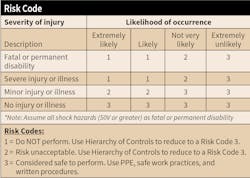Job Safety Planning and the 2018 NFPA 70E
Planning for safety isn’t new to the electrical trade. Guidelines to conduct a job hazard analysis (JHA) for each individual job were first published by OSHA in 1989, and have since been regularly revised. However, complying with the 2018 edition of NFPA 70E “Standard for Electrical Safety in the Workplace” requires the completion of an in-depth “job safety plan,” probably in more detail than what most employers and electrical workers may conduct today.
Some workplaces use generic forms, often referred to as a job safety analysis (JSA), for identifying hazards and determining methods to mitigate those hazards. Whether referred to as a JSA, JHA, or other company-specific term, the objective is the same: Provide a structured method for workers to recognize hazards and identify the choices they will make to protect themselves from those hazards.
New NFPA 70E requirements
The 2018 edition of NFPA 70E contains new requirements for the worker to analyze the critical steps of the electrical job, assess the electrical hazards associated with those steps, and then determine how they will protect themselves. Prior to this edition of the standard, there was no requirement for workers to perform such a detailed risk assessment. This new requirement for a job safety plan must also be reviewed as part of the required job briefing. Should a change in work scope occur during the course of the job, the job safety plan must be revised as needed, and an additional job briefing must occur to reflect any change. Remember, the purpose of the job safety plan is to have the qualified electrical worker review each step of the job they are to perform, determine how safe it is to perform that particular task, and what actions are needed to ensure they will be protected.
OSHA Part 1926 “Safety and Health Regulations for Construction” requires the person in charge of the job to conduct a job briefing. Rules for job briefings have appeared in NFPA 70E since 1995. However, there is no reasonable assurance that the properly conducted job briefing itself will identify all electrical hazards. To ensure hazards are properly addressed, the job safety plan requires:
- The employee in charge, who must also be a “qualified person,” is responsible to complete the job safety plan and job briefing.
- The job safety plan must be documented.
- The plan must include both a “shock risk assessment” and an “arc flash risk assessment.”
- The plan must identify work procedures involved, special precautions to be taken, and the energy source controls for the equipment undergoing work.
Both shock risk assessments and arc flash risk assessments require the electrical hazards be identified and the likelihood of the occurrence and potential severity of any potential injury be considered. Once this information regarding the hazards is identified, any specific protective measures needed are determined. As expected, the assessments must be documented.
Completing the job safety plan
NFPA 70E doesn’t specify an exact type of job safety plan form be used for documentation. It is expected that companies will review and modify (as applicable) their own JSA, JHA, or similar documents used to plan work. The key points of the document is that each critical step of the job is analyzed for electrical hazards, and logical decisions are made to protect workers based on items such as use of work procedures, PPE, or other special precautions. In some cases, it may be identified that a particular step may not be completed safely at all, and other means, such as lockout/tagout must be used.
Informative Annex F Risk Assessment and Risk Control has been expanded for the 2018 edition of NFPA 70E to help companies and workers with the process of risk assessment. While different methods of job safety planning are mentioned, the concept of using a “risk assessment matrix” is typical for many organizations. A basic example of such a matrix is provided in the Annex. For a risk assessment matrix that assigns a risk code to each critical step see the Sample Risk Code Matrix.
Drawbacks
Workers who do not normally complete such detailed job safety plans may object to the complexity of the new requirements. It can be argued that determining the likelihood of an occurrence, or the potential severity of an injury, is subjective. Routine tasks are just that — routine, and should not require any special planning.
There is always a learning curve to any new process. Job safety plans can be streamlined for many jobs. Individual work steps should already be incorporated as part of a standard work or maintenance procedure. But when it comes to routine work, warning flags should go up. Human performance studies indicate such work can be more dangerous than tasks performed less often.
There’s a reason for proper job safety planning. Electrical accidents may not occur as often as other types of incidents, but they have much higher fatality rates. They typically happen in a fraction of a second, and the results can be disabling injuries/fatalities. Thinking about the job to be performed, what could go wrong, and how to best protect oneself before the job begins are effective methods of reducing risks to workers.
Barnett is a certified electrical safety compliance professional (CESCP). He can be reached at [email protected].
Sidebar: Sample Risk Code Matrix
NFPA 70E requires the person-in-charge, who also must be a qualified person, “To estimate the likelihood of occurrence of injury or damage to health and the potential severity of injury or damage to health.” This is required as part of both the shock risk assessment and arc flash risk assessment [Sec. 130.4(A)(2) and Sec. 130.5(A)(2)].
A common method to estimate the likelihood and severity is through the use of a matrix. For example, if the critical step is to “Measure 480VAC” inside an energized panel, a fatality can result. Using the Risk Code matrix, at the intersection of the horizontal line “Fatal or Permanent Disability” and the vertical line “Extremely Likely” is a Risk Code “1”. However, in reality, the person-in-charge may estimate that a qualified worker (after properly inspecting the equipment and finding it to be safe for normal operation, wearing the appropriate personal protective equipment (PPE), following electrical safe work practices, and adhering to company policies and procedures) would be “Extremely Unlikely” to incur an electrical shock. The intersection of “Fatal or Permanent Disability” and “Extremely Unlikely” is a Risk Code “3”. Risk Codes identified as “3” may then be performed.
When analyzing the potential for an arc flash, if the incident energy in this example were to be 1.0 cal/cm2 at the working distance, (less than the onset of a second degree burn), then the person-in-charge may estimate that only “Minor Injury or Illness” would occur in the event of an arc flash when wearing company PPE and following safe work practices. The person-in-charge may also estimate that it is “Very Unlikely” that such an event would occur. Tracing a horizontal line from “Minor Injury or Illness” in the far left column to where it intersects with “Not Very Likely” in the vertical column identifies the Risk Code as “3”. Thus, once again, it would be safe to proceed with the voltage measurement.
Properly designed job safety plans provide workers with a practical tool to analyze the electrical hazards they encounter and an efficient means to determine the best protective measures to be taken for their safety.


